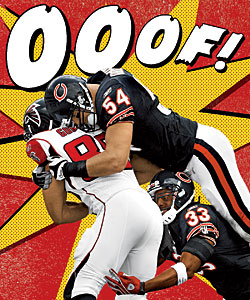
Big changes have been forecast for the National Football League. Everyone from the ESPN analyst Tony Kornheiser to Bill Savage of Northwestern University’s English department has opined that the last snap for America’s most popular sport—as we know it, anyhow—is as inevitable as a beer commercial during the two-minute warning. The reason: growing concerns about the aftereffects of gridiron concussions, grim stuff ranging from memory loss to suicidal depression.
This is where fans panic, anticipating an onslaught of new rules. Tackling will be outlawed! Quarterbacks will throw from behind electric fences! The country’s very fabric will be torn asunder as our true national pastime withers and dies.
Calm down, folks. After interviewing medical experts, trainers, and the leader of the NFL’s concussion committee, I’m convinced that won’t happen. Yes, football will become safer, thanks to important changes meant to curtail brain injuries. But blitzes and crossing routes aren’t going anywhere.
That’s because the most significant modifications are likely to occur behind the scenes. Those alterations will “make the games as safe as they can possibly be without losing the excitement,” says Hunt Batjer, a neurosurgeon at the University of Texas Southwestern Medical Center who cochairs the NFL’s Head, Neck, and Spine Medical Committee.
The NFL has already instituted new practice rules that subject players to fewer hits between games. Now it’s turning to technology to help track the blows a player’s head absorbs over time. The league is currently testing out accelerometers inside helmets to measure those impacts. As the numbers add up, players who have been exposed to particularly dangerous levels of contact could see their on-field activity restricted (though Batjer says more study is needed before any decisions are made). Says Tory Lindley, the director of athletic training services at Northwestern University and a former athletic trainer in the NFL: “If I have a choice between 250 exposures [to potential head trauma] and 100, I’m taking 100.”
Additionally, says Jordan Grafman, the director of brain injury research at the Rehabilitation Institute of Chicago, the NFL is likely to require more healing time before a concussed player can return to the field. (That time could stretch to a year or more: Jahvid Best, the young running back for the Detroit Lions, hasn’t played since suffering a concussion in October 2011.) Grafman thinks there’s even the possibility of forced retirement for players with a history of concussions.
So although the cast of characters on the field may have a shorter run, the game of professional football—what actually happens in the stadium—may not change much at all.
The tricky part of all this is that the medical world still doesn’t fully understand how people recover from concussions. Doctors do know that head injuries don’t affect every person the same way. To decide if a patient has recovered, they have little more to go on than the patient’s feedback. “It’s not like a fracture, where you can look at an X-ray and know with 100 percent certainty that someone is fully recovered,” says Pietro Tonino, chief of sports medicine for Loyola University Health Systems in Maywood.
That puts doctors in a difficult spot, considering the gladiator nature of football. After all, it’s not just the fans who don’t want the game to change. Brian Urlacher, the ferocious linebacker for the Bears, told HBO in January that he would lie about concussion symptoms to keep playing.
That attitude is common in football, says Tonino, and “it makes it difficult for doctors to take care of these guys.” (The Bears declined to comment for this story, referring all questions to the league’s front office.)
The bottom line, of course, is that if the game changes too much, people may stop watching—and there goes the NFL. According to Allen Sanderson, a sports economist at the University of Chicago: “[Fans] are willing to tolerate a little violence . . . as long as there’s no one bleeding to death on the 50-yard line.”
All fans ask is for some minor changes that will allow them to enjoy the game with a clear conscience. The NFL’s challenge is to make those changes happen—and soon.


